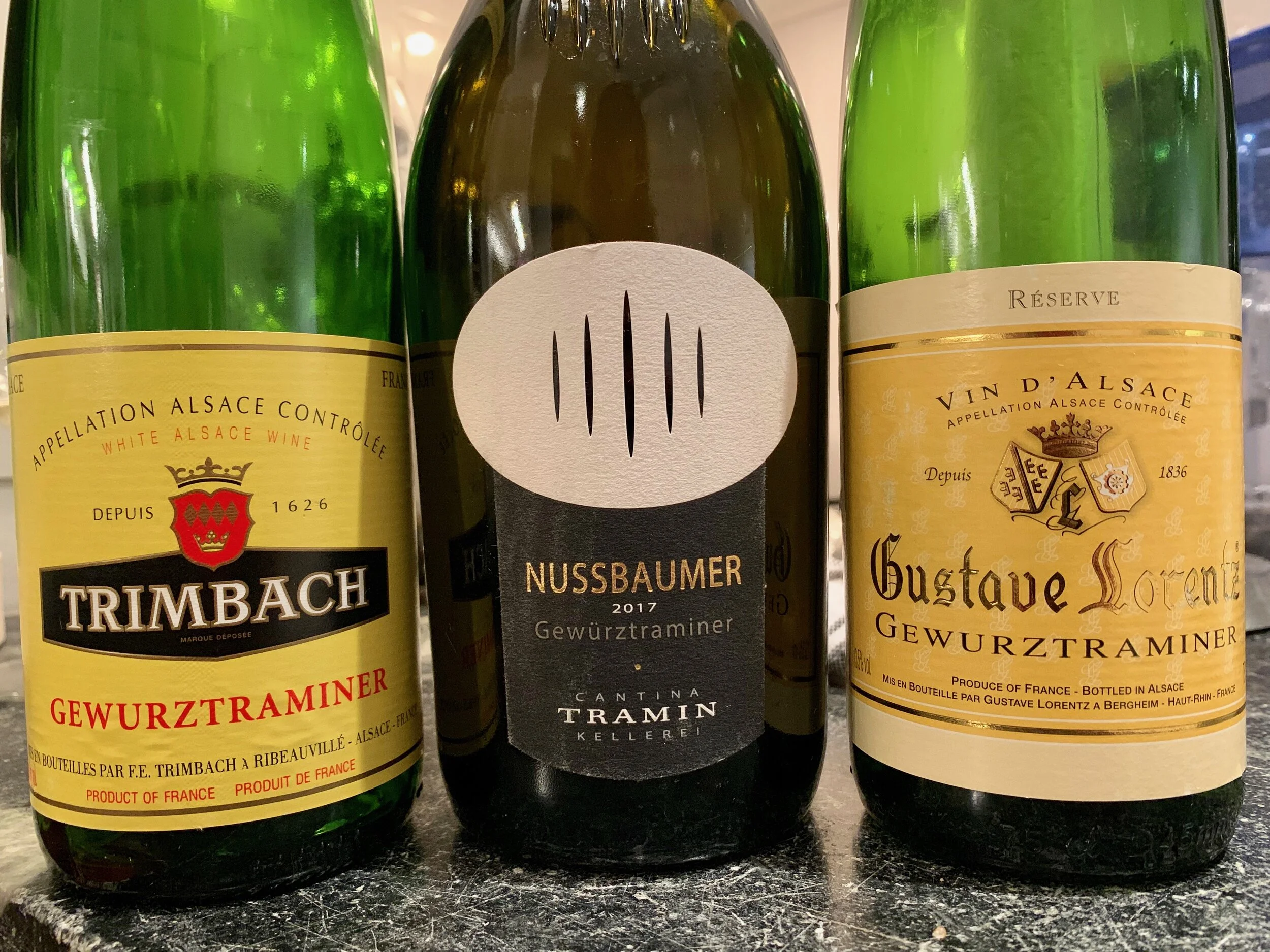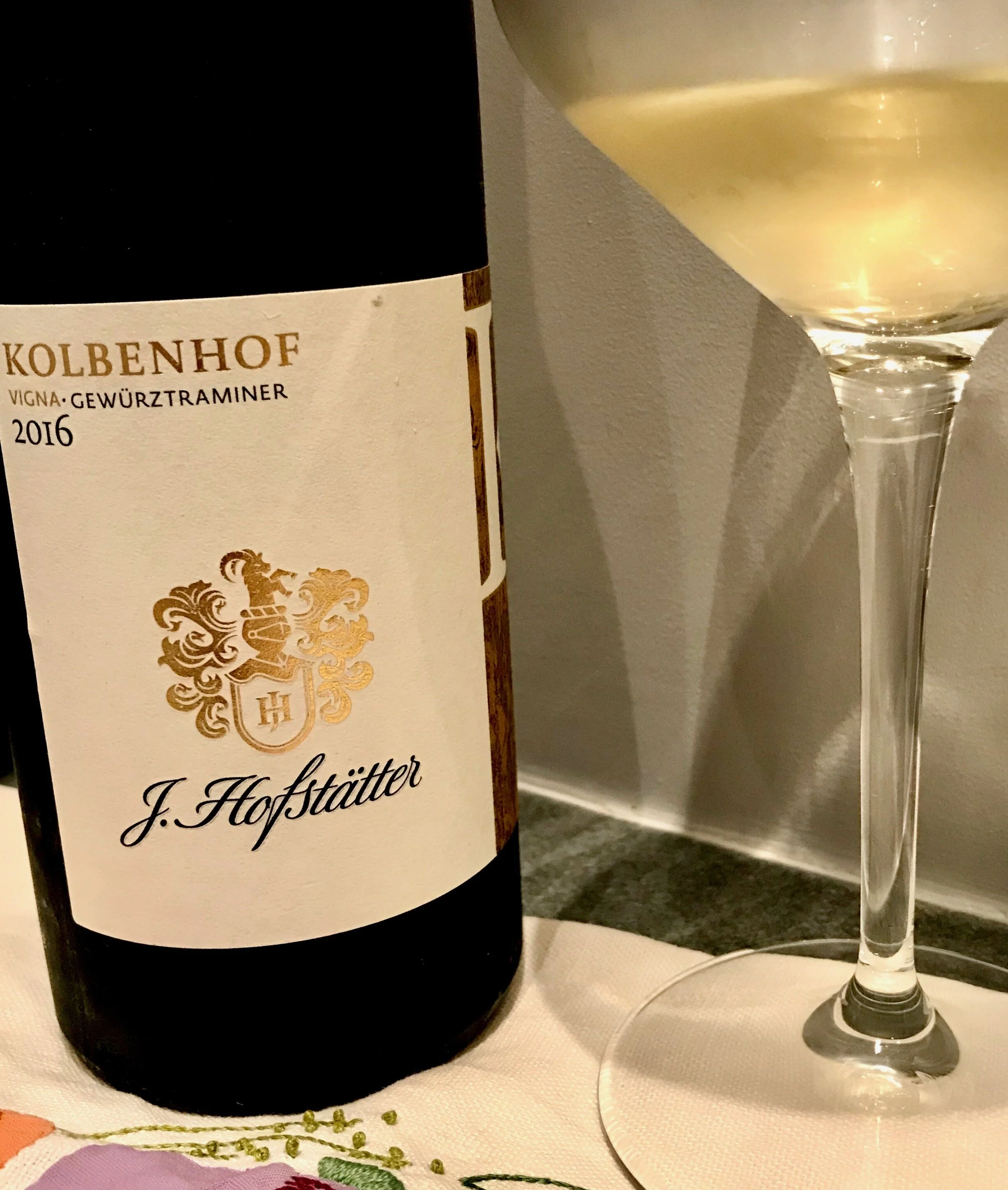Finding Armpit Vibes (and more!) in Gewurztraminer's Flamboyant and Distinctive Aromas
/Gewurztraminer is no shrinking violet. This aromatic white wine cries out for attention the minute it lands in your glass and is easily recognizable for its pronounced scent of lychee. It can also have aromas of rose petals, ginger, cloves, pepper, and armpit — yes, I said it, armpit. But more on that later.
In a blind tasting, the unmistakable smell of lychee is what gives the wine away — the fragrance jumps out of the glass and greets your nose with a serious wake up call.
“Gewürz” means “spiced” in German, as in seasonings or condiments that are used to give a little oomph to a dish. (Note: In German, the wine is written Gewürztraminer, but in Alsace, the umlaut over the “u” (as in ü) is not used.) The most intense Gewurztraminers typically come from Alsace, in northeastern France, where it is the second most planted grape variety after Riesling. But you can find excellent examples all over the world, especially from the cool alpine slopes of Alto Adige in northeastern Italy where it has been planted for hundreds of years. It’s also grown in Germany, Austria, the United States, and Australia.
Fans of Gewurztraminer appreciate what they perceive as attractive aromas, yet its detractors are overwhelmed by these same scents which can come off as too assertive. The best Gewurztraminers hail from cool, sunny regions where this early-ripening grape can slowly and steadily develop its perfumes and power. If the weather is too warm, the grapes will lack acidity and the wine will taste flat, overly alcoholic, and unbalanced. And picking the grapes at the right moment is essential for making a good Gewurztraminer. If the grapes are picked too early, they will be bland and uninteresting at best, if they are picked too late, they will taste fat and overblown.
FOOD PAIRINGS WITH GEWURZTRAMINER
Gewurztraminer’s intensity needs to be paired with very flavorful food. With a dry one, I would suggest spicy Asian, Indian, Latin American, or North African cuisine. With sweeter Gewürztraminers, rich dishes like lobster bisque, Indian curry and most desserts go well. Both styles are great with cheese, especially pungent types like Parmesan and Roquefort. A classic Alsace dish of tart flambée with gruyère and ham is another great pairing suggestion.
GEWURZTRAMINER TASTING
Recently I led a tasting of 10 Gewurztraminers, 8 from Alsace, 2 from Alto Adige, and 1 from Texas. The attendees were 6 millennial women, most of whom had never had a Gewurztraminer before. As you will see, their observations on the wines were interesting, varied, and quite funny:
“I smell passionfruit but also a little bit of armpit b.o. but not necessarily in a bad way. I’m not gonna lie, I’m getting armpit vibes!”
“Way too fruity for me, almost like orange juice.”
“This one tastes weirdly good. It’s interesting how it tastes of olives and of lychees.”
“Smells like basil and I love basil.”
“It has an ocean vibe, smells salty, but with herbs & spice like cinnamon and cloves, and a very distinct taste.”
“Smells like raspberries, licorice, and alcohol. It tastes different than it smells. It tastes like olives and mushrooms, very savory — how is it possible it tastes so different than it smells?”
“Smells like a sharpie, sort of like gasoline. The taste is really good but I don’t like the smell.”
“Smells like lime.”
“Smells like honey and tastes like it too.”
“Less fruity and more floral. More toned down scents and flavors, not so “in your face as some of the others.”
“Smells minty, herbal. Tastes a lot sweeter than the others. I don’t love sweet wines but it could be good with desserts.”
“Smells like rose petals, lychee, coconut and a little peachy. It’s a little bitter, but it smells like what it tastes like.”
“A very distinct smell of Worcestershire and honey barbecue sauce. It’s tangy and would taste good with barbecue.”
“Very fruity. Smells like it’s a sweet wine and tastes like Arizona green tea. I like it.”
“Smells good! It smells like a really sweet perfume, like gushers or a grapefruit roll up, but it smells better than tastes. It’s very sweet with a bad aftertaste of tomatoes and oysters.”
“Tastes really good and interesting.”
When all was said and done, there were three clear favorites, one from Alto Adige, and the other two from Alsace.
Everyone loved Cantina Tramin’s Nussbaumer 2017 Gewürztraminer ($35). Cantina Tramin is one of the top producers in Alto Adige, a region that is said to be the home of Gewürtztraminer, originating in the Italian village of Tramin, where the variety has been cultivated for hundreds of years by family-owned estates. In Alto Adige, the wines are known for their minerality and acidity due to being planted at an average of 2,000 feet above sea level. The Nussbaumer wine is deeply aromatic, rich in body, with a fine juiciness, salty minerality, and long finish.
“The only Gewürztraminers that can compete with Alsace’s are those from Alto Adige, and of these, Nussbaumer is the best.” Ian D’Agata, Decanter, January 2015
The other two favorite Gewurztraminers were from Alsace which has ideal growing conditions for the grape: cool weather and lots of sunshine. These wines tend to be full-bodied, intensely aromatic, and dry with a slight bitterness at the back of the palate. There are sweet versions of the wine made in Alsace as well.
The 2013 Trimbach Gewurztraminer was a clear favorite during the tasting. For three centuries, the Trimbach family has been producing fine wines that are structured, long-lived, fruity, elegant and balanced. This one was appreciated for its aromas of cinnamon, nutmeg, lychee and rose petals (no armpit in this one!). Rich and luscious, yet very well balanced, the wine has a dry, spicy finish and I enjoyed it for dinner with grilled fish, salad, and goat cheese.
The other favorite Gewurztraminer from Alsace was the 2016 Gustave Lorentz, a slightly sweet, but well-balanced wine with floral and tropical fruit aromas. The Lorentz family has been making wine since 1836 in the heart of Alsace and all of their vineyards are certified organic.
Seek out these three wines and others (from Alsace: Zind-Humbrecht, Hugel, or Domaine de Paul Blanck; from Alto Adige: the 2016 J. Hoffstatter Kolbenhof) to find out which ones are your favorites.




























